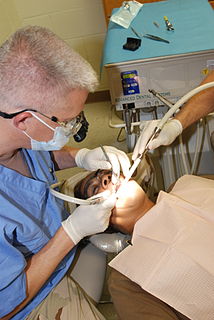Maxillofacial prosthetist and technologist is the term used in the United Kingdom for a specialist who delivers facial, ocular and other prostheses which restore form and function to the body.

The United Kingdom (UK), officially the United Kingdom of Great Britain and Northern Ireland, is a sovereign country located off the north-western coast of the European mainland. The United Kingdom includes the island of Great Britain, the north-eastern part of the island of Ireland, and many smaller islands. Northern Ireland is the only part of the United Kingdom that shares a land border with another sovereign state, the Republic of Ireland. Apart from this land border, the United Kingdom is surrounded by the Atlantic Ocean, with the North Sea to the east, the English Channel to the south and the Celtic Sea to the south-west, giving it the 12th-longest coastline in the world. The Irish Sea lies between Great Britain and Ireland. With an area of 242,500 square kilometres (93,600 sq mi), the United Kingdom is the 78th-largest sovereign state in the world. It is also the 22nd-most populous country, with an estimated 66.0 million inhabitants in 2017.

Craniofacial prostheses are prostheses made by individuals trained in anaplastology or maxillofacial prosthodontics who medically help rehabilitate those with facial defects caused by disease, trauma or birth defects. They have the ability to replace almost any part of the face, but most commonly the ear, nose or eye/eyelids. An ocular prosthesis and hair prosthesis can also be classified as craniofacial prostheses. Prostheses are held in place either by biocompatible drying adhesives, osseointegrated implants, magnets, or another mechanical means such as glasses or straps. Prostheses are designed to be as similar as possible to the natural anatomy of each individual. Their purpose is to cover, protect, and disguise facial disfigurements or underdevelopments.

In medicine, a prosthesis or prosthetic implant is an artificial device that replaces a missing body part, which may be lost through trauma, disease, or a condition present at birth. Prostheses are intended to restore the normal functions of the missing body part. Amputee rehabilitation is primarily coordinated by a physiatrist as part of a inter-disciplinary team consisting of physiatrists, prosthetists, nurses, physical therapists, and occupational therapists. Prostheses can be created by hand or with CAD, a software interface that helps creators visualize the creation in a 3D form.
In the United States, this specialty is known as anaplastology.

The United States of America (USA), commonly known as the United States or America, is a country comprising 50 states, a federal district, five major self-governing territories, and various possessions. At 3.8 million square miles, the United States is the world's third or fourth largest country by total area and is slightly smaller than the entire continent of Europe's 3.9 million square miles. With a population of over 327 million people, the U.S. is the third most populous country. The capital is Washington, D.C., and the largest city by population is New York City. Forty-eight states and the capital's federal district are contiguous in North America between Canada and Mexico. The State of Alaska is in the northwest corner of North America, bordered by Canada to the east and across the Bering Strait from Russia to the west. The State of Hawaii is an archipelago in the mid-Pacific Ocean. The U.S. territories are scattered about the Pacific Ocean and the Caribbean Sea, stretching across nine official time zones. The extremely diverse geography, climate, and wildlife of the United States make it one of the world's 17 megadiverse countries.

Anaplastology is a branch of medicine dealing with the prosthetic rehabilitation of an absent, disfigured or malformed anatomically critical location of the face or body. The term anaplastology was coined by Walter G. Spohn and is used worldwide.
In the UK, [1] the main governing body for the practice of maxillofacial prosthetics is the Institute of Maxillofacial Prosthetics and Technologists.

Oral and maxillofacial surgery specializes in treating many diseases, injuries and defects in the head, neck, face, jaws and the hard and soft tissues of the oral (mouth) and maxillofacial region. It is an internationally recognized surgical specialty. In countries such as the UK and most of Europe, it is recognized as both a specialty of medicine and as such a medical degree or both a degree in medicine and dentistry is compulsory. In almost every other region including the United States, Canada,, Australia, New Zealand, India, and all Asian countries, as well as all of Scandinavia OMS is a recognized specialty of dentistry. For all countries outside of the UK and Central Europe around the world, the dental specialty residency of oral and maxillofacial surgery may or may not include a full degree in medicine.




